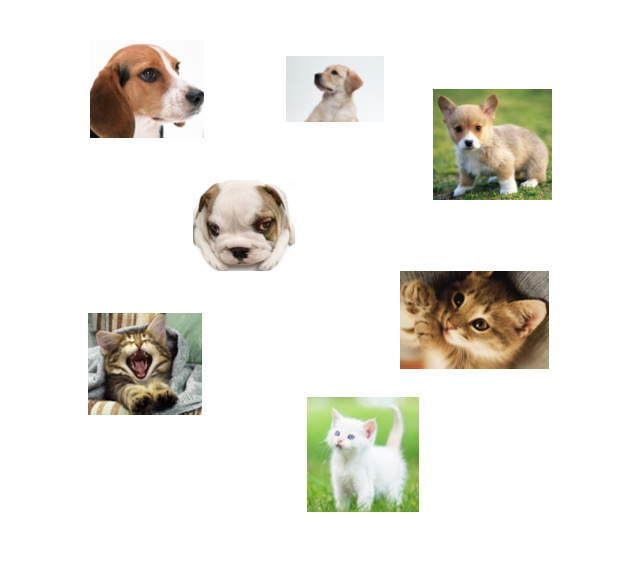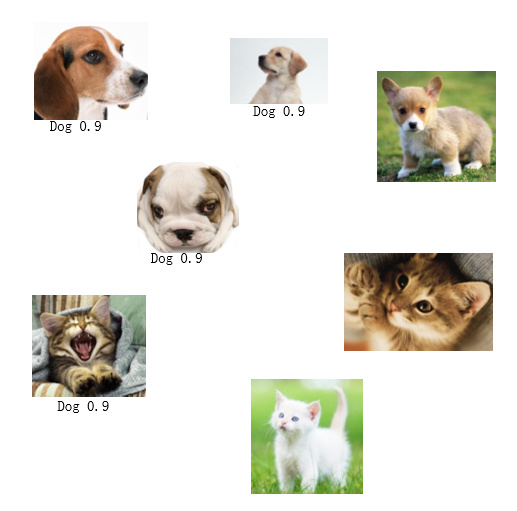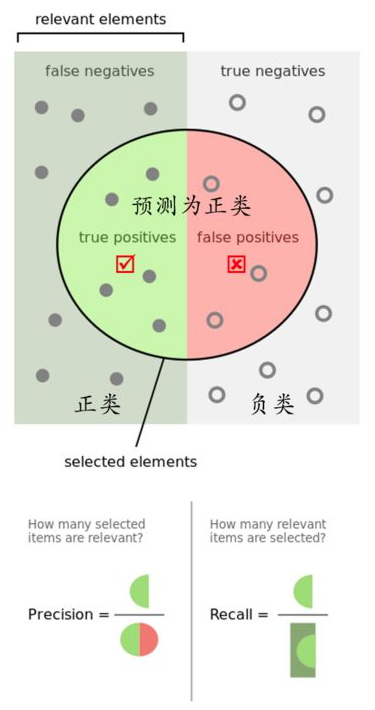0x00 基本概念
在说明mAP这个概念之前,我们先要说一下两个新的概念:precision和recall。这是论文中经常提及的两个概念。我们举这样的一个例子:
我们现在有一个检测狗的任务,但是这个任务数据中包含了猫。那么我们这个时候就有一个问题,我们怎么描述一个物体被检测出来呢?为此,我们引入了IOU这个概念
我们规定IOU > 0.5表示物体被检测出来,否则没有。

现在我们有了这个指标,我们开始跑数据。假设我们已经把网络训练好了,接着找来一张图片测试(这张图片上有四个狗和三只猫),测试结果这样的(我们的目标是找图片中的狗)

标注的数字表示IOU值,我们只选择IOU > 0.5的物体。
那么,这个时候问题又出现了,我们怎么描述我们检测的结果怎么样呢?这个时候就出现了precision和recall。我们先不急着说明这两个概念是什么,我们先看上面的结果,我们发现,我们要找的目标是狗,结果查找的目标中有猫,这显然不是我们希望看到的。我们希望通过一个指标去描述这个问题,所以我们提出了precision,precision是描述查找一个目标的精准率。我们还发现一个问题,就是我们漏找了,明明右上角是一只狗,结果没有找出来,为了表述这个问题,所以我们提出recall,recall是描述查找一个目标的漏检率,recall很多地方翻译为召回率,我更喜欢称它为漏检率或查全率。
我们将被正确识别的狗,称为True positives。我们将被正确识别的猫称为True negatives。为什么会有这个概念?什么是被正确识别的猫?我们知道我们这里的目标是找狗,那么那些我们没有标注的猫,是不是从反向说明我们的查找准确率(precision)呢?接着,我们定义被错误识别为狗的猫为False positives。被错误识别为猫的狗称为False negatives(就是右上角的狗,受IOU指标影响)。这些概念很重要,不要记错了!!!
接着我们就定义
- p r e c i s i o n = T r u e p o s i t i v e s T r u e p o s i t i v e s + F a l s e p o s i t i v e s precision=\frac{True positives}{True positives+False positives} precision=Truepositives+FalsepositivesTruepositives
- r e c a l l = T r u e p o s i t i v e s T r u e p o s i t i v e s + F a l s e n e g a t i v e s recall=\frac{Truepositives}{Truepositives+Falsenegatives} recall=Truepositives+FalsenegativesTruepositives
我们就很容易的计算出这里的
p
r
e
c
i
s
i
o
n
=
3
4
precision=\frac{3}{4}
precision=43,
r
e
c
a
l
l
=
3
4
recall=\frac{3}{4}
recall=43 。最后说一点,如果我们把IOU标准设置为IOU > 0的话,这个时候的recall会越来越接近于1,而相应的precision也会降低,这很容易理解。
另外还有一个概念accuracy
- a c c u r a c y = T r u e p o s i t i v e s + T r u e n e g a t i v e s T r u e p o s i t i v e s + F a l s e n e g a t i v e s + T r u e n e g a t i v e s + F a l s e p o s i t i v e s accuracy=\frac{Truepositives+Truenegatives}{Truepositives+Falsenegatives+Truenegatives+Falsepositives} accuracy=Truepositives+Falsenegatives+Truenegatives+FalsepositivesTruepositives+Truenegatives
我们这里很容易计算出 a c c u r a c y = 3 + 1 3 + 1 + 2 + 1 = 4 7 accuracy=\frac{3+1}{3+1+2+1}=\frac{4}{7} accuracy=3+1+2+13+1=74。最后放一张很经典的图片

0x01 代码
我们这里使用的评估脚本是按照VOC数据集的标准来的,预测结果按如下格式:
<image identifier> <confidence> <left> <top> <right> <buttom>
VOC数据集总共有20类,也就是说,我们最后要得到20个结果文件。例如,对于car,输出结果
comp3_det_test_car.txt:
000004 0.702732 89 112 516 466
得到这些文件后,我们可以通过以下脚本,计算对应的mAP
我这里简单提一下脚本中的AP计算问题
def voc_ap(rec, prec, use_07_metric=False):
if use_07_metric:
# 11 point metric
ap = 0.
for t in np.arange(0., 1.1, 0.1):
if np.sum(rec >= t) == 0:
p = 0
else:
p = np.max(prec[rec >= t])
ap = ap + p / 11.
else:
mrec = np.concatenate(([0.], rec, [1.]))
mpre = np.concatenate(([0.], prec, [0.]))
for i in range(mpre.size - 1, 0, -1):
mpre[i - 1] = np.maximum(mpre[i - 1], mpre[i])
i = np.where(mrec[1:] != mrec[:-1])[0]
ap = np.sum((mrec[i + 1] - mrec[i]) * mpre[i + 1])
return ap
我们注意到这里的AP计算有两种
- 11点插值法,这个算法的思路很简单。就是选取0,0.1,0.2…1,这样的11个点,分别对应不同的recall级别,根据不同的级别计算最大precision,然后求出它的平均值。
- 第二种就是我们文中提到的方法
reference:
The PASCAL Visual Object Classes Challenge (VOC2007)
如有任何问题,希望大家指出,谢谢O(∩_∩)O























 1674
1674

 被折叠的 条评论
为什么被折叠?
被折叠的 条评论
为什么被折叠?








